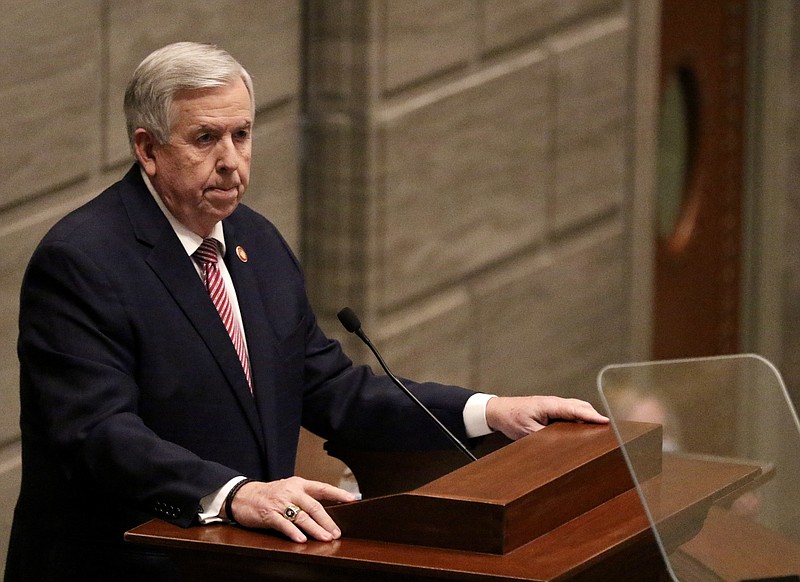Missouri Gov. Mike Parson last week proposed a well-funded 2022 state budget thanks to federal cash buoying pandemic-related revenue losses.
Many of Parson's budget priorities are consistent with his administration's long-standing goals, from workforce development to infrastructure.
State Budget Director Dan Haug said the optimistic projection for the $34.1 billion budget is a product of savings secured from CARES Act funds for state and local governments.
Parson's budget proposal is just the first step in drafting the next state spending plan. Lawmakers will use the document as a starting point for crafting the final version, which they must pass by May. The new budget year starts July 1.
Medicaid
Medicaid takes up the largest chunk of the pie. Medicaid expansion was passed by Missouri voters in August via ballot initiative and will tack an additional $1.9 billion onto the state's budget.
Most of the additional costs are covered by the federal government, while the state expects to pay around $120 million out of the general revenue fund.
The expansion permits coverage enrollment for Missourians in households with incomes at or below 133 percent of the federal poverty guidelines. The budget proposal expects 275,000 additional Missourians to qualify and enroll in the program.
The governor played to the key of frequent Republican talking points surrounding expansion of the program, emphasizing the need for cost-saving measures by "staying vigilant in maintaining the program's integrity by protecting against fraud and waste."
Haug said the state is saving some money on Medicaid expansion because it will be possible to move some people already receiving assistance into the expansion program, which has a better federal reimbursement rate.
Childhood development, K-12, higher education
The governor's proposal looks to fully fund the education formula for K-12 schools and expects funding for higher education to return to pre-pandemic levels, although questions regarding exactly how much cash the federal government ends up providing for the upcoming fiscal year remain unanswered.
University of Missouri System President Mun Choi requested $438 million from lawmakers Tuesday, including $10 million for the NextGen Precision Health Institute. Choi asked for the NextGen funding to be considered part of the university's core funding instead of being treated as an addition to the budget.
Parson's budget recommendation is below that request and does not make NextGen a core element of UM funding, although lawmakers could change that.
Popular scholarship programs such as the A+ Schools Program, Bright Flight and Access Missouri are seeing increases in funding at similar levels to this year.
Additionally, the plan calls for funding workforce development programs that incentivize a pipeline for high-demand jobs in the state, such as the Fast-Track scholarship program and MOExcels, which the Legislature did not fund last budget cycle because of concerning COVID-19 projections.
Infrastructure
Reflecting Missouri's well-documented infrastructural needs, the proposal requests $25 million from the state for transportation cost-share programs "to help communities fulfill other infrastructure projects," the governor said.
"You cannot fund workforce development without infrastructure," Parson said in his State of the State Address on Wednesday.
Twenty-one percent of the state's rural roads are in poor condition, and 9 percent of the state's rural bridges are in poor or structurally deficient condition, with the state ranking as one of the 20 worst states in the nation in both categories. Missouri has the second-lowest fuel tax in the nation.
Patrick McKenna, director of the Missouri Department of Transportation, said additional stimulus dollars in the recently passed Relief Act also play a large role in filling gaps in revenue.
"Actually, that was something we advocated for," he said, "which was to create a kind of a backstop for state DOTs related to revenue losses from COVID."
Cash for port improvements and maintenance repairs to state facilities are also part of the budget proposal - as well as expansion of high-speed broadband services to bridge the digital divide among rural communities, which have been disproportionately affected during the pandemic.
Other priorities
Parson's budget includes a 2 percent pay raise for state employees and an incentive program.
Pandemic-specific costs also continue. The budget calls for $2.4 million for dashboards and data analysis capabilities, such as the site the state has built for COVID-19-related statistics.
Parson's proposal also includes $100 million set aside in case of unforeseen problems.
"I am committed to leaving Missouri in a better financial position than I found it," the governor said.
The work of the Missouri News Network is written by Missouri School of Journalism students and editors for publication by Missouri Press Association member newspapers.

